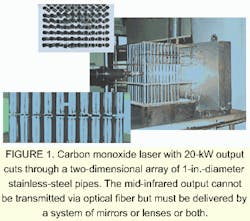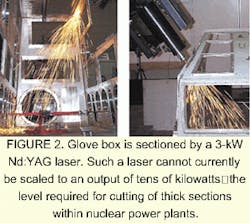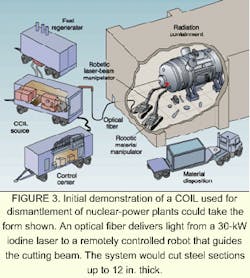Fiber-coupled chemical oxygen-iodine lasers may soon dismantle nuclear-power plants; they also show promise for general industrial use.
Marc R. Hallada, Stephen L. Seiffert, Robert F. Walker, and John Vetrovec
The dismantlement of obsolete nuclear-weapon production facilities and nuclear-power reactors is a major challenge for the US Department of Energy (DoE) and commercial nuclear-power utilities. It is also an international problem, with dangerous reactors and Cold War weapons facilities endangering both environment and health and increasing the threat of proliferation. The USA has hundreds of obsolete weapons-production facilities in urgent need of dismantlement; other nuclear nations undoubtedly have similar numbers of facilities.1 It is estimated that the republics of the former Soviet Union have more than 400 obsolete military nuclear reactors, many on decaying naval vessels. Worldwide, hundreds of commercial power reactors also will need to be decommissioned in the next 30 years.
FIGURE 1. Carbon monoxide laser with 20-kW output cuts through a two-dimensional array of 1-in.-diameter stainless-steel pipes. The mid-infrared output cannot be transmitted via optical fiber but must be delivered by a system of mirrors or lenses or both.
Existing tools cannot decommission nuclear reactors in an expeditious, safe, and cost-effective manner. New methods are needed to accelerate decommissioning schedules and to efficiently segregate wastes so that materials can be reused as much as possible and long-term storage requirements are minimized. Economic and convenient dismantlement of obsolete facilities would reduce the dangers of accidents and proliferation and simplify the monitoring and control of the remaining facilities. In addition, while only a small number of countries currently depend on nuclear power, in the years ahead it may become a power source for others, as well; thus, safer and less-labor-intensive decommissioning tools will become ever more important. High-power laser systems offer a potential solution for the dismantlement of nuclear-power plants.
Existing technology is limited
Conventional dismantlement technologiesplasma arcs, water jets, oxygen-gas torches, diamond wires, and othershave several limitations. They are often labor-intensive and expensive, they usually generate significant secondary waste streams, they sometimes require bulky equipment that cannot be used in confined areas, and many of them cannot quickly cut through the thickest components or certain materials. As a result, multiple tools are required to conduct dismantlement operations, even for similar tasks. Although these conventional tools are able to accomplish many of the dismantlement tasks, they require extensive labor for setup, maintenance, and operation.
A number of recent demonstrations have shown that laser systems can be highly effective toolsand perhaps the only feasible toolsfor certain dismantlement tasks.2 The Nuclear Power Engineering Corp. (NUPEC; Tokyo, Japan) demonstrated the use of a 20-kW carbon monoxide (CO) laser for single-pass cutting of large arrays of stainless-steel pipes and for cutting through a 12-in.-thick stainless-steel core support plate (see Fig. 1). At the DoE Hanford, WA, site, a Nd:YAG beam was fiber-delivered into a glove box to do simple cutting tasks using existing remote manipulators.
FIGURE 2. Glove box is sectioned by a 3-kW Nd:YAG laser. Such a laser cannot currently be scaled to an output of tens of kilowattsthe level required for cutting of thick sections within nuclear power plants.
About a year ago, researchers at Sandia National Laboratories (Albuquerque, NM) used a 3-kW Nd:YAG to section a glove box made of 0.125-in.-thick stainless steel (see Fig. 2). They used a sophisticated, rapid route-planning technique to cut out hypothetically contaminated sections of the structure, avoiding any underlying rib structures. Many plutonium-processing glove boxes are actually thicker than this, however, and are often partially laminated with lead plates, greatly complicating the sectioning and disposal of these transuranic-contaminated structures.
Full advantages not realized
The full benefits of using lasers in decontaminating and dismantling nuclear facilitiesreducing secondary wastes, maintenance, and labor; increasing processing rates and safety; and reducing costshave yet to be seen. To realize these benefits, and for users to see lasers as high-payoff tools, both high average powers and delivery via optical fiber are essential. The demonstrations so far have used high average powers or fiber delivery, but not both. As a result, laser systems are held out as an option for the future but have not been chosen for any near-term projects.
While the CO laser cutting demonstration at NUPEC was impressive, it did not provide a practical system because the mid-infrared (IR) beam (4-8 µm) could not be transmitted by standard industrial optical fibers. The hard-optics beam-delivery systems required for such wavelengths are prone to misalignment and have high losses from beam spillover, absorption, and reflections at each optical interface. Carbon dioxide (CO2) lasers suffer from similar transmission losses and also do not couple as well into many metals as do near-IR lasers, cutting at about one-third the rate for comparable lasers near 1 µm. So, although CO and CO2 lasers can be scaled to very high powers, the lack of a convenient delivery system is a major problem.
Current industrial laser systems that can be delivered via standard fused-silica fiberoptics (which transmit over a wavelength range of approximately 0.4-1.6 µm) are not capable of the high average powers needed for practical dismantlement systems. Near-IR Nd:YAG systems, the beams from which can be delivered by standard fibers, have not been demonstrated at average powers greater than approximately 4 kW from a single device. At higher powers, thermal distortions of the solid-state media reduce the beam quality drastically, making efficient injection of the beam into fibers a much more challenging proposition. (Fiber core diameters are limited to no more than about 600 µm to preserve fiber flexibility in accessing confined areas; bend radii are also limited at high powers by light leakage into the cladding, which can potentially destroy the fiber.) Also, with a marginally sufficient power density on the objects to be cut, the laser focus has to be precisely maintained on the surfaces, and only thin sections can be cut at practical rates.
From military to civilian use
A laser that could meet nuclear-dismantlement needsfiber-deliverable and scalable to extremely high average powerscould be built now by modifying a military weapon laser. The chemical oxygen-iodine laser (COIL) was invented and developed by the US Air Force, beginning in 1977, as a weapon system.3 As a gas-transfer laser, COIL systems are scalable to very high powers without loss in beam quality. Such a laser has been demonstrated at more than 100 kW; an airborne version is now being built, at much greater powers, to shoot down ballistic missiles from hundreds of kilometers.
A high-power industrialized COIL emitting at 1.315 µma wavelength easily transmitted by standard fused-silica fiberopticswould be a versatile tool for dismantlement and recycling operations. It could be used for cutting, welding, or scabbling (surface ablation); its high average power could also allow multiple workstations to be used simultaneously.
The technology is well understood (the Air Force has invested hundreds of millions of dollars in COIL development), and industrialization is being pursued by groups in the USA and overseas.4 Although US industry has a substantial technical lead in high-performance military COIL systems, a consortium of Japanese companies and universities is aggressively pursuing industrial systems and applications. Its ten-year goal is to develop a 500-kW COIL as a centralized laser source for various industrial applications.5
In the USA, a 20-kW preprototype industrial COIL was built by the Rocketdyne division of Boeing (Canoga Park, CA) about seven years ago, in just 22 months. A much-more-efficient and maintainable device could now be constructed using knowledge gained in the Airborne Laser program and in COIL industrialization work at the University of Illinois at Urbana-Champaign (UIUC).
At UIUC, a small Air Force COIL device has been rebuilt to efficiently operate with nitrogen as the carrier gas and to be more maintainable for long-term operations. Electrochemical regeneration of the chemical fuels is now under development at Boeing. Regeneration would greatly reduce operating costs and allow the laser to operate completely on electricity.
High-power fiber delivery
Another new project being pursued collaboratively by Brookhaven National Laboratory (Upton, NY) and the Russian Federal Nuclear Center (Snezhinsk, Russia), under the auspices of the DoE International Proliferation Prevention program, will address fiber delivery (including use in high-radiation environments), optimal resonator designs for fiber injection and cutting and processing specific nuclear components and materials. High-power fiber delivery has been demonstrated by several groups, including the Air Force (delivery of a 7.2-kW COIL beam through a 600-µm fiber) and GSI Lumonics (Kanata, Ontario, Canada; delivery of a more than 5-kW Nd:YAG beam through a 600-µm fiber).
By using a variable magnetic field in the laser gain region (which produces hyperfine Zeeman splitting of the atomic iodine energy levels), US military researchers have demonstrated high-power pulsed COIL outputs at tens of kilohertz, while researchers at Tokai University have demonstrated precise output-power stabilization even while mechanically vibrating the laser cavity. Also, military COIL development in the USA has focused on chemical excitation for its compactness in high-power systems. Prospects for electrically excited high-power iodine lasers have motivated a resurgence of interest in this area by US, Japanese, Russian, Chinese, Korean, and Czech researchers.
The dismantlement of nuclear facilities is perhaps the most attractive near-term application of an industrialized iodine laser, due to the urgency and extremely high costs associated with the tasks (see Fig. 3). In addition, in this application a chemical rather than electrical prime power source could be very convenient because electrical power supplies may not be easily available.
Industrial iodine lasers also could open up several other laser applications. They could, for example, make possible the cost-effective cutting and welding of lightweight aluminum alloys for the auto and shipbuilding industries, because the near-infrared wavelength couples well into these high-reflectivity materials and permits the continuous, deep-penetration welds that are essential.
Laser-hardening the surfaces of railroad rails has been shown to substantially increase their lifetimes, but a high-average-power laser such as a COIL would be essential for a practical system; such a laser could do in situ hardening of rails while mounted on a track-maintenance vehicle traveling at several miles per hour. A fiber-delivered, high-average-power iodine laser could also permit the practical use of lasers in drilling and cutting geologic materials.
Developing an industrial COIL
To take advantage of the large military investment in COIL technology, the first step would be to build a portable industrial prototype, perhaps at a power of 15 kW, and demonstrate its capabilities for a number of applications. Applications in nuclear-facility dismantlement appear to offer the most attractive place on which to focus, but other industrial uses could be tested with the same device. The system could also serve military interests in a reliable and cost-effective testbed for tactical laser defensive systems.
The cost of building, testing, and deploying an industrial COIL device will run into millions of dollars. While no current industrial laser can accomplish the tasks that a fiber-delivered, high-average-power COIL could, the large cost for deploying the first one has prevented any single group in the USA from taking on this task. The US defense contractors that developed COIL technology are focused on military missions and are not motivated to undertake the technical and financial challenges associated with building an industrial COIL. However, the strong US lead in this technology has not stopped overseas groups from investing heavily in this area. Coupled with sophisticated robotic systems, COIL technology has the potential to effect large improvements in the disposal of obsolete nuclear-weapon facilities and power reactors.
REFERENCES
- "Estimating the Cold War MortgageThe Baseline Environmental Management Report," chap. 4, DOE/EM-0232 (1995).
- J. Vetrovec et al., Proc. ICALEO 1999, San Diego, CA, paper 1408 (Nov. 1999).
- K. A. Truesdell et al., Proc. 10th GCL Conference, SPIE 2502, 217 (1994).
- J. Vetrovec, SPIE 3092, 723 (1996).
- M. Endo, SPIE 3268, 106 (1998).
MARC R. HALLADA and STEPHEN L. SEIFFERT are staff scientists and ROBERT F. WALKER is senior scientist at Schafer Corp., 2903 Renard Place SE, Ste. 300, Albuquerque, NM 87106; e-mail: [email protected]. JOHN VETROVEC is integrated program team lead at Rocketdyne Propulsion and Power, The Boeing Company, 6633 Canoga Ave., Canoga Park, CA 91309.


